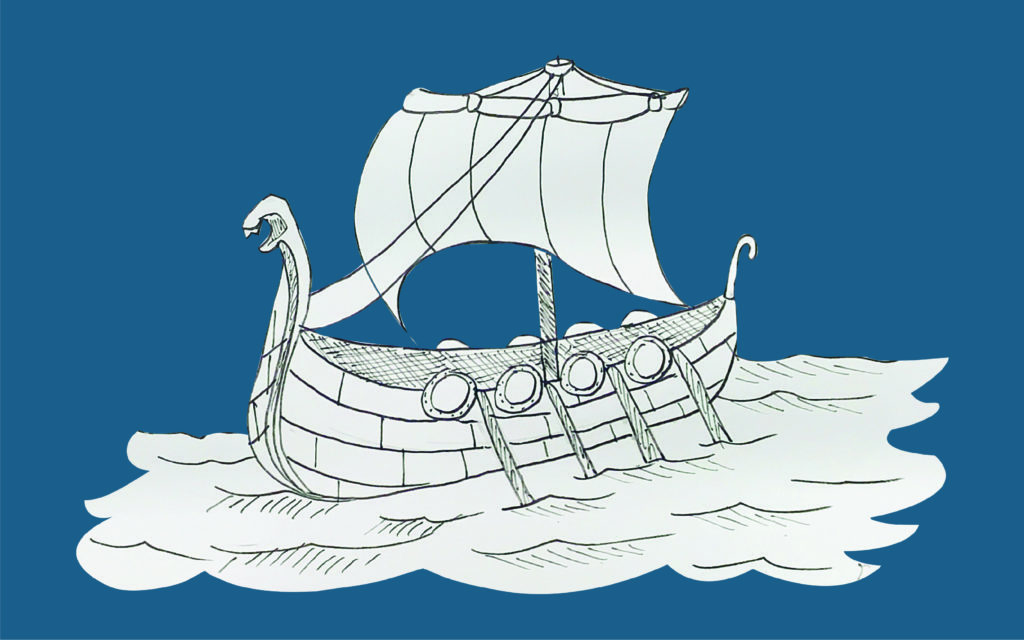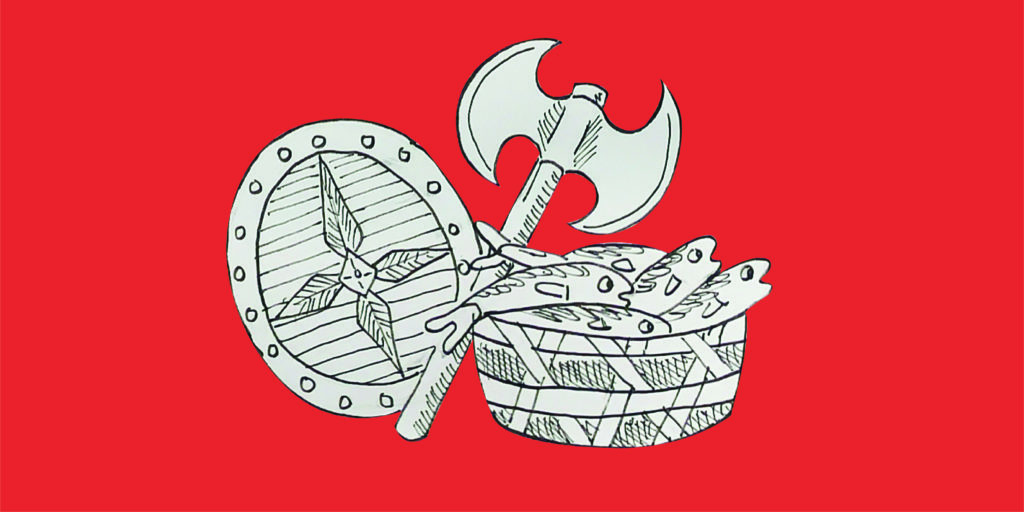Adapted from Brunner’s new book, Extreme North – A Cultural History
When Geneva historian Paul Henri Mallet began to publish Old Norse tales in 1655, he could probably not imagine the persisting wave of interest in all things “nordic” more than 250 years later. Although the Old Norse tales feature the sort of wild adventure more often associated with heathens than Christians, they were written down in the 13th century in Christianized Iceland and influenced by that faith. It is not known what the originals were used by a certain Snorri Sturluson, Saxo Grammaticus, and others who were part of this effort.
After Mallet’s History of Denmark had been translated into several languages, European writers took an immediate interest. German philosopher Johann Gottfried Herder read Mallet’s book with great enthusiasm. For him, the stories created a sense of belonging to an imagined homeland in the North. He felt he was entering new territory: Old Norse mythology as an alternative to a stale classicism that venerated Greco-Roman legends and myths. Many people at the time were sick of the South. The craze also caught on with Victorians who traveled to Norway to discover their roots. Iceland, Norway, Denmark, and Sweden were perceived as a large single cultural unit vaguely connected by Viking history. A notion even circulated that Queen Victoria was related to Odin.
It didn’t take long until Old Nordic motifs made their way into popular culture. Stories about such a rough-hewn warrior people just fired the imagination. Mostly likely inspired by the presumed garb of the Celts or Gaul, the costume designer for Richard Wagner’s Ring of the Nibelungen outfitted the performers with horned helmets. As we know today, the classic “Viking” bronze horned helmets, found in Denmark, date back to 1000 BCE — or around two thousand years before the Viking age. And there is no evidence that the Vikings, those mythic explorers, and conquerors, wore them. Most likely they just had caps made of leather or metal.
More recently, our understanding of this legendary warrior people has become far more nuanced, and many a myth has been dispelled. Rudolf Simek, professor of ancient German and Nordic studies at the University of Bonn, Germany, points out that we have only the flimsiest evidence of how men and women of Viking times might have looked: “There is no indication whatsoever that they had tattoos or piercings, except horizontally scratched teeth painted in black, the meaning of which is unclear.” As can be gleaned from pictorial representations and carvings, Viking men sported all kinds of haircuts, from pot cuts to half-long wavy hair. “They had goatees, mustaches, and full beards, but little braids are nowhere to be seen! Also, the floor-length hair of Viking women is likely to be wishful thinking, but they certainly had long hair — the longer the nobler — and Irish ribbon knots which would have needed hair needles or nets to stabilize them,” Simek says. “As Danish women researchers stress these days, the clothing at least of the elite was more colorful than we had previously imagined, with colored woven ribbons and fur trims.”
Movies about these people tend to depict them as almost superhuman figures. However, in fact, measurements of Viking remains show that the men stood on average 5 feet 7 inches and the women 5 feet 2 inches tall.
Nor is there any truth to the idea that the heathen Vikings waged a religious war against Christianity, even if it may have seemed that way to the Christian monks they brutally attacked. Vikings were “only” interested in plunder, while the monks spoke of a war of faith as a way of enlisting support from their coreligionists. In truth, some evidence suggests that Vikings were fascinated by the figure of Jesus Christ, about whom they had learned from their prisoners and from missionaries. They even viewed the “white savior” as a deity equal in stature to the Norse gods, Thor and Odin.
Likewise, the myth of Viking invincibility is less the result of their actual, technical military superiority than their habit of launching surprise raids to get their hands on valuable loot. Good timing was the key. Viking ships landed before the targets of attack had time to sound the alarm, and they disappeared just as swiftly.

Recently, Scottish comedian Eleanor Morton asked on Twitter: “When are they going to make a historically accurate Viking drama consisting mostly of farming?” The question resonated with many people, most probably because they begin to understand that the Vikings must also have had real, “normal” lives beyond just progressing from one spectacular battle to the next. Indeed, many of today’s researchers believe that, although certainly capable of using arms to defend their homes and honor, the majority of people known as “Vikings” lived off of agriculture, fishing, and trade and spent their lives in the places they were born. In any case, Viking raiders were more like the highway bandits of their time, i.e. exceptions, rather than typical representatives of the culture from which they came.
Did female Vikings do battle as well? The excavated “Birka warrior” in Sweden suggests they did. An ax, a sword, two horse cadavers, and a board game were found in this woman’s grave, and when it was discovered in 1878, excavators assumed the occupant had to have been a man. It would be more than a century before Swedish researcher Charlotte Hedenstierna-Jonson and her team would prove the opposite using DNA analysis. The case also showed how unable many were of imagining a world in which men and women were free of fixed gender roles and how often scientists misinterpret archaeological evidence. On the other hand, the bones of the female warrior show no signs of any sword blows or other effects of direct participation in fighting. It’s possible that the woman was a battlefield commander. But critics have also speculated that she may have been interred in the wrong grave. Some researchers think that Viking household chores were divided between the sexes and that there were Viking “househusbands,” since large cooking pots and skewers were also found in the graves of men. While the role of female Vikings — including “spear women,” as the Valkyries referred to themselves — has attracted a lot of research interest among modern-day scholars, it remains to be proved conclusively whether there was a division of labor between the sexes or if women and men really enjoyed egalitarian roles.
In her book Valkyrie: The Women of the Viking World, the Icelandic medievalist Jóhanna Katrín Friðriksdóttir writes:
We exoticize them, but upon closer examination, it emerges that we have surprisingly many things in common with the Vikings: like them, we are also living in a time of shifting gender roles, migration, fluctuating economies, new media and technology, and the global flow of goods — a time in which the world changes rapidly and unpredictably.
The limitless brutality of Viking movies is a topic unto itself, and there are even more questionable phenomena associated with the continuing popularity of Old Norse tales and Scandinavian deities. A contemporary Germanic paganism, called Ásatrú, has been attracting followers for decades, spawning communities in North America and Europe. Its believers worship Odin. The movement heroicizes northern European pre-Christian traditions and preaches the alleged superiority of the White race. Images of Valhalla, the imaginary heaven reserved for Viking warriors, often inform this ideology, together with fears that Europe, as a spiritual homeland, under threat by immigration from Muslim countries and condemned to destruction. Racist, anti-Muslim, and anti-immigrant sentiments are rife among such groups, which have repeatedly clashed with the law. Neo-Nazis make pilgrimages to Haithabu (from the Old Norse term Heiðabýr, from heiðr‚ “heathen,” and býr‚ “yard”), a major archaeological museum near the North German city of Schleswig on the site of a former Viking trading post for herring, grain, and cloth. Likewise, the annual medieval Viking festival on the site of a former Viking settlement in the Polish town of Wolin in the Baltic region attracts right-wing visitors from Germany and Russia who carry shields and wear T-shirts and tattoos sporting swastikas, SS skulls, and the slogan “blood and honor.” Needless to say, none of that corresponds to the historic reality of the Vikings. Last but not least, the tattoos displayed by the so-called QAnon Shaman when he stormed the US Capitol — the valknut, the yggdrasil (the world tree), and Thor’s hammer — are influenced by Norse mythology.
What are the reasons for our obsession with the Vikings? Be it Northman or Marvel’s Thor franchise — what needs are serviced by such tales from a world that no longer exists and perhaps never did in the form that we imagine? Is it couped in periods of anxiety-like the one in which we currently live? These are questions worth asking since, as The Northman shows, our fascination with mythological Norse figures runs deep and is unlikely to abate any time soon. •




